
(Most recent first. Click on the titles for fuller descriptions).
6th December 2022
Having related the story of his early career on a previous occasion, the speaker, club member John Hayes, completed his tale today. This covered the period from the time when, having been an enthusiastic ‘born again’ Christian and church preacher, he had come to lose his faith. At the time, his life was in crisis from a number of causes: the beliefs that had formerly been the bedrock if his existence had dissolved, his family life was proving very difficult, and he had become involved in an affair with a married woman. All of these circumstances meant that he had to resign from his job as a minister of religion and, because he was living in a ‘tied’ house belonging to his church, he had to relinquish it.
As John said, without a job and without a home he was close to a nervous breakdown but, after a succession of unskilled or semi-skilled jobs, he rediscovered his sense of purpose when he found employment that he enjoyed in the ‘legal costs’ business. (This is one that provides professional advice on maximising the recovery of costs for solicitors and other similar organisations). Eventually establishing his own company, he has seen it grow until over a hundred people were employed in a dozen offices around the UK.
Now clearly at peace with himself, John described the principal things that have given, and continue to give, meaning to his life – the enjoyment of walking in the countryside, listening to classical music, the study of fine art, his work, and politics. He is an active supporter of the Welsh National Opera and, although no longer a member, was once very much involved with the Labour party.
In summarising his talk, he stressed that the purpose of life is to enjoy being alive. Wise words, indeed!
 John Hayes and Stefan Andrezcjuk
John Hayes and Stefan Andrezcjuk
15th November 2022
Today’s speaker was to have been John Winkworth-Smith and the title of his talk was to have been ‘Sheep farming unsanitised’. Unfortunately, through illness, John was unable to give his talk so, at the last minute, Chairman Stefan Andrejczuk devised a quiz based on a number of different subjects including local knowledge (Derbyshire and the Peak District), sport, birds, government and politics, the human body, and general knowledge.
In six teams of four members and one team of three, a keenly fought contest was enjoyed by all. As often happens in such events, there was much discussion and dispute about some of the answers but the quizmaster kept a firm grip on the proceedings, ruling that his decisions were final (even if they were wrong).
With a score of 43 points out of a possible maximum of 64, two teams tied for first place. One of these teams was the one with only three members. It therefore claimed a moral victory on the basis that it had been handicapped by possessing only 75% of the brain power of all the other teams.
Prizes, in the form of ‘Snicker’ chocolate bars were awarded to each member of the two winning teams.
On behalf of all those taking part, David Webb thanked Stefan for producing a most enjoyable quiz at very short notice.
1st November 2022
Although frequently in the news, the UK’s housing shortage is by no means a new phenomenon. One of the ways that such shortages have been tackled in the past has been to construct entirely new towns, usually on ‘greenfield’ sites adjacent to the major centres of existing population.
Today’s speaker was club member Tony Crook who, as Professor Emeritus of Town and Regional Planning at Sheffield University, is an acknowledged expert on the subject of housing policy. Tony started his talk by presenting a number of statistics concerning new towns in the UK. There are currently 32 of them, with a combined population of 2.8 million – approximately 4% of the country’s total. Their origins may be traced back to the time when ‘model’ settlements to house their workers were established by some, usually philanthropic, industrialists. Among these were places like Bourneville (by Cadbury), New Lanark (Robert Owen) and Port Sunlight (Lever Brothers). These were followed, in the early 20th century by privately funded ‘garden cities’ (e.g. Letchworth and Welwyn). These examples were seen to be successful and they provided the impetus for government-backed schemes to be introduced.
The speaker then described a number of factors which led to the creation of new towns in the post-World War II period. The 1947 Town and Country Planning Act created a national planning system which was refined and updated by subsequent legislation. As a result, new towns were created to cope with ‘overspill’, initially from London (e.g. Harlow) but later from Birmingham (Telford), from Merseyside (Runcorn) and from Glasgow (Irvine).
Although fulfilling a housing need, these new towns were often criticised for their lack of social cohesion and without architectural merit. They also had the effect of drawing the economic life out of the existing cities. Hence, a re-think of policy has come about since the 1970s. The emphasis has now shifted to one of urban regeneration within the older centres of population. But, irrespective of these changes in policy, the fact remains that, as a nation, we are continuing to fail to meet our housing needs, and we struggle to agree on the method of meeting the demand. The speaker suggested that additional new towns could be one way of meeting these needs.

Tony Crook and Stefan Andrejczuk
18th October 2022
With the dictionary definition of thinking as ‘the process of considering or reasoning about something’, it has been argued, by the famous author on the subject, Edward de Bono, that it is a skill that can be taught. At this meeting the speaker, club member John Robinson, declared himself to have been greatly influenced by the work of De Bono, who was the author of more than forty books on the subject.
Opening his talk with a summary of De Bono’s conclusions, John explained that there are several different types of thinking, including two in particular which De Bono named as ‘parallel’ and ‘lateral’. Crucial to the method of parallel thinking is the principle that individuals contributing to the exploration of a subject must adhere to an agreed line of thought, even though each will approach the process in their own way (i.e. separate from, but ‘parallel’ to, that followed by the other participants in the group). Conversely, lateral thinking involves the solving of problems by an indirect and creative approach, typically through viewing the problem in a new and unusual light.
Turning specifically to some thoughts of his own, the speaker considered the history of human development over the past seven hundred years. In the early fifteenth century, China was the foremost country in the world. Paper, printing and gunpowder were the product of the innovations there at that time, much earlier than in Europe but, from that point, stagnation set in as far as China was concerned. A likely explanation for the Europeans overtaking the Chinese in their development is that the Chinese method of writing (over 40,000 characters) compared with the 26 letters of the Roman alphabet made written communication extremely difficult. With the invention of movable type printing in Europe, this enabled the spread of ideas to race ahead and, in turn, to feed into the innovations which led to the industrial revolution. It is only more recently, with the advanced technology offered by computerisation that the Chinese have been able to compete so successfully with the rest of the world.
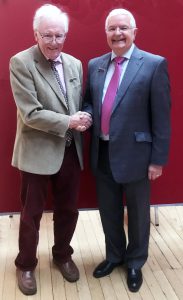
John Robinson and Stefan Andrejczuk
4th October 2022
An abandoned quarry in the heart of the Derbyshire countryside would seem to be an unlikely place to find a museum dedicated to that most urban form of transport, the tram but, as those of us who live in the area are well aware, such is indeed the case. At this meeting, member Chris Shepley introduced a guest speaker, Frank Bagshaw, who gave a most interesting illustrated talk on the history and development of the National Tramway Museum at Crich.
Frank, who has been a supporter, volunteer and fund-raiser for the museum for many years, described how a number of enthusiasts acquired (for the sum of £10) one of Southampton’s trams when that system closed in 1949. Needing to find a home for it, they initially sent it to the Beaulieu Motor Museum but, in 1959, transferred it to Crich where, along with two other trams (from Cardiff and Leeds), it formed the basis of a collection that has since grown to more than fifty vehicles. Originally, these trams operated on many different systems in this country, ranging from Glasgow and Edinburgh in the north, to London and Bournemouth in the south. In addition, the museum contains examples from several European cities and even South Africa. In most cases, these trams have arrived at Crich in a pitifully dilapidated state, requiring enormous amounts of effort and cost (often running into hundreds of thousands of pounds) to restore them to the superb condition in which they can now be seen.
As well as discussing the vehicles themselves, Frank described how the Tramway Village at Crich has been developed over the years. Redundant buildings from elsewhere – such as the Derby Assembly Rooms and the Red Lion Inn from Stoke – have been skilfully rebuilt to create an atmosphere reminiscent of the heyday of trams. And, to augment the museum’s appeal beyond an interest in trams, other attractions, like a woodland walk and sculpture trail, have been incorporated in various parts of the site.
Thanks to the dedication and enthusiasm of people like Frank, we can be proud to claim the Crich museum as one of Derbyshire’s prime visitor attractions.
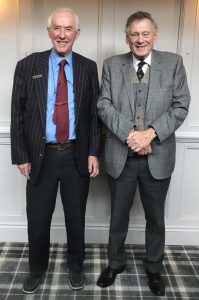
Chris Shepley and Frank Bagshaw
20th September 2022
Opening his talk with the apparently whimsical question, ‘Will a robot join Probus?’, the speaker, club member Ernest Edmonds immediately caught the attention of his audience. This seemed to be a preposterous idea but, as Ernest went on to explain, the development of artificial intelligence is progressing so rapidly that computers, which have been capable of controlling mechanical tasks for many years, can now be used creatively, particularly in the fields of design and art, thus replicating the processes of the human brain.
Describing himself as an artist by inclination, a logician by training, and a computer scientist by accident, the speaker explained how, early in his career, he had written a computer program which would enable a computer to create original artwork in an existing style, based on rules defined by the artist. This pioneering work launched him into a career of computer art and, among many other locations, his work is represented in the V&A Museum as part of the National Archive of Computer-Based Art and Design.
Other developments of his work have included time-based and interactive art which also involve computer-generated images and can be collaborative creations by several people.
In answer to his original question, Ernest expressed the view that artists will not be replaced by robots but their work can be improved by the use of AI.
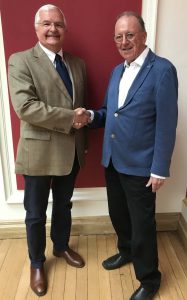
Stefan Andrejczuk and Ernest Edmonds
6th September 2022
When our members are called upon to arrange a speaker for a meeting, many of them choose to give the talk themselves and, in so doing, often decide to tell the story of their own lives and careers. In the past, such narratives have usually been delivered in a matter-of-fact way which avoids disclosing anything about their personal beliefs, especially those concerning their religious faith. However, at this meeting, member John Hayes met this challenge head-on and described how his upbringing and experiences had influenced his attitude to religion and which changed dramatically during his lifetime.
John was born in 1940 into a loving family, but one that provided him with little intellectual stimulation until, at the age of four, he started to attend a local Sunday School (as so many children did in those days). Now involved in the life of the church, he progressed to joining the youth club and regularly (and enthusiastically) attending the church services. Then, aged sixteen, through the influence of an evangelical preacher, he became a ‘born again’ Christian and firmly believed that he had found the meaning of life. Now with a newly-found sense of purpose he started conducting church services and leading Bible study groups. From here, the next step was to train formally to be a minister and he spent six years at colleges of religion, first in Glasgow and later, in London.
It was during his time in Glasgow where, witnessing the deprivation and poverty of the people living in the Gorbals area of the city, his faith began to be undermined and he started to have doubts, when previously he had had certainties. Fighting these feelings, he continued in his ministry but, at the same time, discovered that he had a talent for personal counselling, thus shifting his role from that of a preacher to that of a listener. Finally, at the age of forty, he was confronted with the realisation that his doubts of many years past could no longer be ignored and that, in truth, he had become atheist. Thus, he had lost the very thing that for so long had given his life meaning. But, even so, his feeling was now one of relief.
This was a very personal, frank and courageous talk which was much admired by John’s audience.

John Hayes and Peter Stubbs
16th August 2022
At the end of World War I, Germany was not only a defeated nation but also, due to the onerous conditions of the 1919 Treaty of Versailles, a humiliated, impoverished and, consequently, resentful one. It was against this background that the influence and power of the NSDAP (National Socialist German Workers Party) – known as The Nazi Party – arose during the 1920s and 1930s. The ways in which this party and its philosophies developed from its formation in 1920 were described at this meeting by club member, Ken Watson.
Ken opened his talk by circulating to his audience a copy of the NSDAP’s original political programme (manifesto) which contained 25 items of policy, most of which started with the words, ‘We demand’. An examination of this list revealed that many were indeed socialist in principle, such as the nationalisation of industries, land reform, the provision of state pensions, and an emphasis on the health, education and development of all citizens. However, as a sinister foretaste of what was to come, the ‘Nationalist’ items concentrated on a ‘Germany and the German peoples first’ policy. These included the demand that the Treaty of Versailles be abolished, all German-speaking peoples should be united, colonies and land should be acquired to accommodate the expanding German population, all non-German immigration be stopped and, most ominously, those of non-German blood (in particular, the Jews) not be considered as citizens with equal rights.
The speaker continued by describing the way in which the NSDAP worked its way into government, firstly by democratic means but later by diktat and military force. Its leader, Adolf Hitler, was appointed Chancellor in 1933, after which he consolidated his position, using the support of the SA (the original paramilitary wing of the Nazi party) and, later, the notorious SS and Gestapo. With this military backing, Hitler was free to implement his more extreme policies. Among other measures, trades unions were banned and their funds confiscated, the German Communist Party was barred from voting in the Reichstag (parliament), universal conscription was introduced, and the brutal persecution of the Jews was pursued with vigour. On the international stage, German forces occupied the demilitarised Rhineland in 1936, created the ‘Anschluss’ (union) with Austria in 1938, followed by the takeover of the Sudetenland region of Czechoslovakia and finally, in September 1939, the invasion of Poland which triggered the start of World War II.
By this time, the original 25 items of the NSDAP’s programme had consolidated into a simple six-word slogan – “Ein Volk, ein Reich, ein Führer” (One people, one realm, one leader).
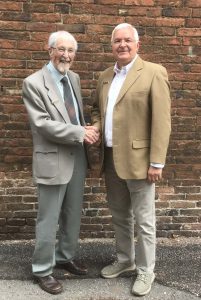
Ken Watson and Stefan Andrejczuk
2nd August 2022
With memories of the British Empire fading into history, we were reminded – by our own member, Robert Graham – of the time when former British colonies gained their independence in the latter half of the twentieth century. In this talk, Robert described his experiences in Nigeria between 1954 and 1965 when, for the first three, and the last three of these years, he was a District Officer in H.M. Overseas Civil Service. For most of the period between 1957 and 1962, during which time Nigeria gained its independence in 1960, he was Secretary to the Governor of Eastern Nigeria, based in the regional capital, Enugu.
After completing a year-long induction course at London University, Robert sailed from Liverpool for Lagos in July 1954 and, on arrival in Nigeria, travelled to Calabar in the East of the country where he took up his position as Assistant District Officer. Although totally new to the work, he was expected to put his hand to a variety of different jobs, as diverse as the supervision of community development projects (roads, bridges, village wells), and the adjudication of disputes between the local people. Over the course of the next few years, Robert was transferred to a number of locations in Eastern Nigeria, some of which were quite small and remote. It was in describing this period of his life that he related several amusing – and, at times, alarming – anecdotes which were very well received by his audience.
By the end of this most entertaining and interesting talk, it was clear that Robert retains a lasting affection for Nigeria, which he described as his ‘second country’. But he expressed a sense of sadness over the ways that it has developed since independence, not least its notorious levels of corruption and periods of inter-tribal violence.
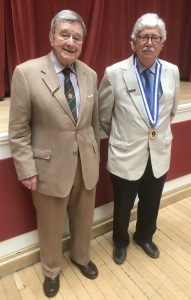
Robert Graham and Peter Stubbs
19th July 2022
The membership of this club can claim to represent a wide variety of career backgrounds mostly, but not exclusively, business and professional. These include senior academic and consultancy positions, engineering and science, and manufacturing. The area of expertise covered by the majority of these professions is reasonably well understood by the public but there is one that can sometimes mystify those unacquainted with its purpose and meaning; namely, Social Sciences. Therefore, it was in order to explain the approach made by social scientists to specific events that Club member David Webb (Emeritus Professor of Social Sciences at Nottingham Trent University) addressed his fellow members at this meeting.
Opening his talk by defining social science as one of the branches of science devoted to the study of societies and the relationships among individuals within those societies, David expanded his theme by giving a number of examples about which a more nuanced view could be taken than that commonly held. For instance, in the folk memory of the Second World War, said David, Bomber Command has played second fiddle to the heroic endeavours of Fighter Command. This might be to do with the ideal of individual, almost chivalric, combat of the young, sometimes socially privileged fighter pilot, whereas bombers have a more industrial approach to warfare, where killing (often of civilians) is remote and less invested with glamour – and, of course, there was the residual collective guilt that ‘carpet-bombing’ was tantamount to a war crime.
Another topic addressed by the speaker was that of the traveller community. He described how the social reaction to those who are not settled, the labelling of them as ‘deviant’, the sanctioning of their life style and the shaping of travellers’ own identity as ‘outsiders’ all lead to a spiral of antagonism between the settled and the traveller – from which it becomes progressively difficult to pull back.
Finally, he considered ‘charity’, as being something of which we are all in favour. “Or are we?”, David asked. At first sight the voluntary gift of money or time to those in need seems honourable, but there is plenty of evidence that charitable giving serves as way for the giver (especially if wealthy) to enhance their social standing, to build up their reserves of influence and to shape the direction of the lives to whom their giving is directed. Those in receipt of charity may be required to display their need, which easily places them in the position of supplicant, and may also reinforce stereotypes that certain groups are self-evidently deserving. It’s not an easy transaction (based on power), raising questions over who may in fact be benefitting from the giving of charity.
Clearly, this was a thought-provoking talk and one which prompted a lively discussion among the members of the audience.
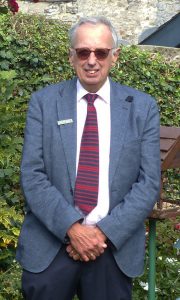
David Webb
5th July 2022
The sometimes unnerving developments in the use of artificial intelligence (AI) – both existing and potential – were the subject of this talk given by our Secretary, Jonathan Wicksteed. In an earlier talk, five years ago, he had outlined the then-current situation which, even in this relatively short period of time, has changed dramatically. As previously, he pointed out that there are numerous ways in which AI can be used beneficially – in medical advances, bio-engineering, nanotechnology and the like – but there are many sinister and potentially harmful uses to which AI can be (and, in many cases, already is) employed.
We are now very familiar with drone technology which is capable of providing low-cost and speedy methods of aerial surveying and indeed, can be used to create spectacular artistic light displays such as those for the recent Platinum Jubilee celebrations. But, in contrast to these non-threatening applications, the same technology can be used for military purposes, with drones now having the added ability – by using AI – to seek out their targets without direct input from their operators, thus changing the very nature of conflict itself.
Jonathan continued by discussing other ways in which developments in computing have led to new methods of warfare. Cyber-attacks have become ever more common, and these now have the potential of destroying vital infrastructure – for example, electricity and water supplies, banking systems or transport. Huge sums need to be spent to defend these facilities in a continual effort to thwart such attacks.
Yet another ominous development in AI has been its utilisation for the surveillance of citizens. We are all aware that our use of the internet is monitored for targeted advertising but, with the increasing use of voice and facial recognition in conjunction with CCTV systems, it is possible for far more information about us to be accumulated, often for questionable purposes. The authorities in China seem to be leading the way in this particular technology.
Concluding his talk with a brief description of quantum computing (which can lead to vastly more powerful and quicker computers), the speaker expressed his concern that our children and grandchildren may face even greater threats, but also opportunities, than we do.
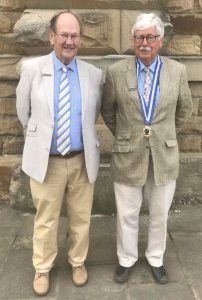
21st June 2022
Maritime trade between the countries of the Far East (such as China), and the rest of the world, especially Europe, has been carried out for centuries even though the sea routes involved have been long and hazardous. It was with the objective of finding a shorter route that, from the 15th century, European explorers attempted to establish a commercial sea route – the Northwest Passage – around the American land barrier. In more recent times, as a result of global warming and the consequential shrinking of the polar ice cap, attention has also turned to the potential of a corresponding Northern Sea Route, to the north of Russia/Siberia.
The examination of the feasibility of these routes and their commercial, political and military importance was the subject of this absorbing presentation by club member, Ron Enock. As he pointed out, the commercial benefits of shorter sea routes with their resultant savings in transit times and, hence, cost are obvious, but against this advantage are the difficulties thrown up not only by the hostile environment of these polar routes but also by unresolved questions of sovereignty of the seas themselves.
Territorial disputes over the international boundaries between the nations bordering the Arctic Ocean are proving difficult to resolve especially between countries on opposite sides of the NATO / Russia divide. There are vast reserves of natural resources, such as oil, gas and other minerals, beneath the ocean floor which can only be exploited peaceably if the relevant international borders are agreed. Many of the disputes relate to each state’s claims concerning its territorial waters (which extend 12 nautical miles from the coast) and, more significantly, the associated Exclusive Economic Zone (a further 188 nautical miles). Until these matters can be settled, the area continues to remain one of uncertainty for international commercial shipping.
The speaker concluded his talk by discussing the substantial expenditure on military and economic activity in the polar area by Russia in recent years – a policy which is intended to impose strict control by that country over the Northern Sea Route – a further disincentive to international trade.

Peter Stubbs and Ron Enoch
7th June 2022
Gold: that remarkable, ever-bright metal which, throughout history, has been sought and acquired by man because of its allure and rarity. It has been fought over; indigenous peoples have been invaded and subjugated by others in pursuit of it; and, even today, nature is being destroyed by some of the methods of mining employed by unscrupulous prospectors for it. The story of man’s quest for this particular precious metal was the subject of this talk by member, Bernard Webster.
The speaker opened by describing one of the most famous gold objects to have been created – the 3,300 year-old funerary mask of the ancient Egyptian pharaoh, Tutankhamun. Apart from its artistic merit, the value of its gold content would amount to £500,000 at today’s prices, a sum reflecting the rarity of this metal. As an indication of this scarcity, it has been estimated that, over the past 5,000 years, a total of barely 200,000 tonnes has been extracted from the earth. Much has been used for jewellery, coinage and household items but there are major reserves of bullion in the form of gold bars.
Bernard continued his talk by discussing Australia’s gold-mining operations, both historic and modern. In the mid-nineteenth century there was a gold-rush similar to that which had occurred earlier in California. Thousands of hopeful prospectors from around the world congregated on the fledgling states of Victoria and Western Australia, bringing some prosperity but also much criminal activity in their wake. These days, most mining activity is centred around Kalgoorlie and Coolgardie in Western Australia.
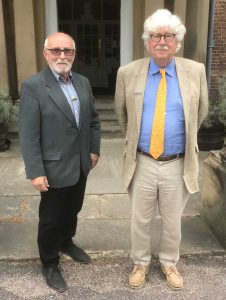
Bernard Webster and Peter Stubbs
17th May 2022
Two air disasters occurring within five months of each other – one in October 2018 and the other in March 2019 – and involving the same type of aeroplane, the Boeing 737 Max, were the subject of this talk by club member, Brian Holland.
Before discussing the causes of these crashes, Brian gave an outline of the evolution of the Boeing 737 series of aircraft, starting with the 737-100 which entered service in 1968 as a competitor to the Douglas DC9, BAC-11 and Sud Aviation Caravelle. Subsequent development of the 737 entailed extending its length (to accommodate more passengers), its range of operation and, significantly, changing the type of engines fitted to it. By the end of the twentieth century, after numerous changes, the plane had evolved into the 737-800. By now its main competitor was the Airbus A320 which, with its related A319 and A321 NEO types, was proving highly successful and popular with airline operators.
Boeing were therefore faced with a dilemma. They could either work on a completely new design or they could change the type of engine. The second option was chosen because it would be cheaper to develop, build and operate, and could be in service sooner than the alternative. However, the aircraft handling characteristics would be compromised by the use of the new type of engine. In order to overcome these problems, Boeing introduced a modification called ‘Manoeuvring Characteristics Augmentation System’ (MCAS) which took over the pitch control of the aircraft from the pilot under certain conditions. Remarkably, to avoid having to introduce simulator training, pilots and customers were not made aware of the introduction of MCAS.
Under these circumstances, the Boeing 737 Max entered service with, among other airlines, Lion Air and Ethiopian Airways, and it was aircraft operated by these two unfortunate customers that crashed in 2018 and 2019 with the loss of all passengers and crew. At the time, Boeing claimed that the cause of both disasters was ‘pilot error’, but later examination of the recovered ‘black box’ recorders revealed that the fault lay in the MCAS system and, in particular, Boeing’s failure to ensure that pilots were adequately trained.
Brian concluded his talk by summarising the findings of the US Report into the causes of these crashes. These included technical design flaws, faulty assumptions about pilots’ responses to MCAS, and management failures by Boeing and the regulatory body, the Federal Aviation Administration. Although the Boeing 737 Max is now back in operation around the world, the cost to Boeing in terms of money and reputational damage has been enormous.
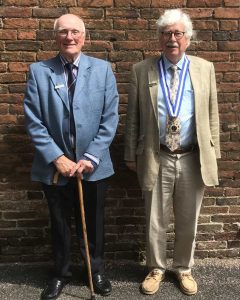
Brian Holland and Peter Stubbs
3rd May 2022
How many of us cling to the belief that we are unable to sing, probably because we were told at school that we couldn’t? But, according to club member John Thurstan who was today’s speaker, everyone (with few exceptions) is able to sing. In an extremely enjoyable and entertaining talk, which included many snatches of choral and other sung music delivered in his fine tenor voice, John related how he had been persuaded to form a choir in his village of Cutthorpe.
Although he had started singing in a church choir as a boy, and had been a member of other choirs since then, he claimed to have been totally unqualified for the task when first approached in 2008. However, he finally gave in to successive requests and, seven years later, let be known that he would indeed attempt to form a choir. Only fifteen potential choristers came to the early rehearsals and, as John described, made a fearful ‘racket’ at first. But eventually, through his guidance and training in breathing exercises and simple songs, progressing to canon and rounds in music, the choir became not only more proficient but also increased in numbers. In developing the choir, he stressed the importance of choristers learning the music which they were singing rather than relying on reading it from a score. In this way, without the distraction of the written music, they maintain eye-contact with their conductor and fellow singers, and thereby enhance their performance.
Since its foundation, the choir has performed at the Cutthorpe Carnival, the village’s well-dressing celebrations, and carols at Christmas. In common with other choirs throughout the country, its activities were abruptly halted by the Covid-19 pandemic but, at last, there is hope that things can soon return to normal.
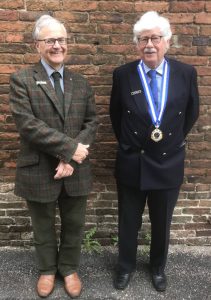
John Thurstan and Peter Stubbs
19th April 2022
The names of three British ships (‘HMS Victory’, ‘HMS Royal Sovereign’ and ‘HMS Defiance’) that fought at the Battle of Trafalgar in 1805 are immortalised on Birchen Edge near Baslow where each of three giant gritstone outcrops is inscribed with its respective name (although, for some unexplained reason, ‘Royal Sovereign’ is incorrectly spelled ‘Royal Soverin’). Why, in this particularly land-locked location, these ships were commemorated here has been a source of puzzlement to many, including our current Vice Chairman, Stefan Andrejczuk, who raised the question at this meeting. In order to help him answer the question, he called on the assistance of a guest speaker, his friend Capt. John Wills RN Rtd., whose naval background enabled him to provide some useful suggestions.

John’s career in the Royal Navy commenced in 1970 as a cadet at the Britannia Royal Naval College, Dartmouth, and concluded in 2008 with the rank of Captain RN. During this time he came to specialize as a Marine Engineer Officer, which included an appointment as Senior Engineer of the Royal Yacht Britannia. Later, in his role as Second in Command of the RN barracks in Portsmouth, (called HMS Nelson), he became involved in The 1805 Club which is dedicated to the preservation and care of the memorials and graves of those associated with the navy of the Georgian era. In fact, it was The 1805 Club which, in 1992, restored the 3-metre high Nelson’s Monument also on Birchen Edge near to the three ships outcrops.
Turning to the ships’ names on the rocks, the speaker explained that it is understandable for Victory and Royal Sovereign to be honoured because the former was Vice Admiral Lord Nelson’s flagship, and the latter was under the captaincy of Collingwood, his second in command. However, it is not so obvious why Defiance was chosen for the third outcrop. A number of explanations have been offered. Maybe the Duke of Rutland on whose land the monuments stand, was instrumental in selecting this particular ship for recognition? However, it is understood that two of the ship’s crew were from Derbyshire, which could have influenced the choice. This, in John’s view, is the most likely reason.
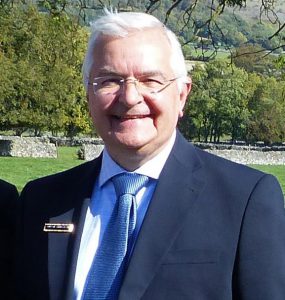
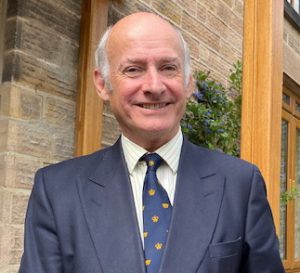
Stefan Andrezcjuk and Capt. John Wills RN Rtd
5th April 2022
Known as the Merry Monarch, King Charles II was the subject this talk by Chairman, Peter Stubbs. However, it was the story of a less than merry period of this king’s life that was told on this occasion because the speaker concentrated upon the time (43 days) during which the king managed to avoid capture by his pursuing enemies, the Parliamentarians, during the English Civil War.
As Peter explained, civil war broke out in 1642 with the royalist forces of Charles I (‘Cavaliers’) pitted against the Parliamentarians (‘Roundheads’) over the manner of England’s governance and religious differences. At this time, the boy who was to become Charles II was twelve years old but, by 1645 at the Battle of Naseby he had already been made titular commander of part of the royalist army. Following the royalists’ defeat at Naseby, he left England and spent the next five years exiled in France and the Netherlands. In 1649, Charles I was beheaded and England became a republic under Oliver Cromwell. Soon afterwards, the Scottish parliament proclaimed Charles II as ‘King of Great Britain’, an arrangement that was unacceptable to Cromwell. A series of battles between the forces of Charles and Cromwell culminated in the Battle of Worcester (3rd September 1651) at which Cromwell was victorious.
Thus began the six-week period during which the king was pursued by the Parliamentarians all over the West Midlands and the South of England as he tied to evade capture. Being remarkably tall for his day, Charles was hampered by his conspicuous appearance but he was able to rely on his many loyal supporters who could find hiding places, most famously in an oak tree in Boscobel Wood on the Shropshire/Staffordshire border. Eventually, Charles and his closest companions reached Brighton where they managed to board a ship and escape to safety in France.
The speaker included in his talk a description of the character and influence of Charles II. He was known to be witty, affable and charming, but could be lazy, devious and dishonest. As for a successor, he failed to produce a legitimate heir even though he fathered nine children (as far as is known) and had at least seventeen identified mistresses (including the famous Nell Gwynn). A Merry Monarch, indeed!

Peter Stubbs
15th March 2022
Now an annual event in March, this year’s debate considered the proposition, ‘Is the removal of statues a futile attempt to rewrite history or a proper way of stopping the celebration of oppressors and their values?’ Leading the discussions were members David Catton who supported the proposition and Paresh Solanki who opposed it, with club Chairman Peter Stubbs overseeing the proceedings.
In defence of statues which may now be considered controversial, David acknowledged that, although the acceptable standards of society may have changed over time, the historical events commemorated by such memorials remain unchanged. Using the example of Edward Colston whose statue was demolished by protesters in June 2020, this man was a prominent slave-trader at a time when this was an acceptable practice, and he used his wealth to beneficial effect for the citizens of his native city. In his honour, a new concert hall in Bristol was named ‘Colston Hall’ when built in the mid-nineteenth century but, in the face of the 2020 protests, this has now been renamed ‘Bristol Beacon’. Nevertheless, despite its name-change, this venue still serves its original purpose which was made possible by Colston’s philanthropy. Hence, the attempted rewriting of history (by demolishing Colston’s statue and consequential renaming of the hall) was not appropriate.
In response, Paresh argued that the removal of statues was not so much an attempt to rewrite history as to correct it, by placing on record all the relevant facts about the person commemorated. Statues are symbolic of the values held by that person and, by their existence, reinforce those values in the eyes of the viewer. Hence if, as in the example of Colston, his statue was intended to recognise his philanthropy it may succeed in doing this, but it provided an incomplete picture. The removal of statues from prominent locations does not necessarily mean that they must be destroyed – they can be relocated to less public sites where the reasons for their removal can be explained by plaques or other means.
Having listened to the arguments put forward by the two leaders of the debate, members of the audience added their own contributions. Overall, the opinion of the meeting was that the removal of statues in this way was not merited. However, it was recognised that being in a senior age group and, as residents of this overwhelmingly ‘white’ area of Derbyshire, the members of this Probus club are representative of only a part of society. Thus, it is very difficult to appreciate the views and concerns of others, especially those from communities with a very different history from our own.
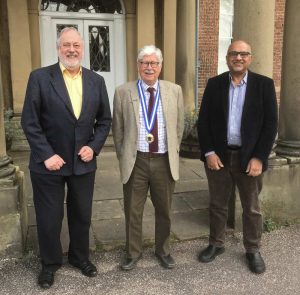
David Catton, Peter Stubbs and Paresh Solanki
1st March 2022
Making his second visit to our club (albeit after an interval of eleven years), the guest speaker today was Colin Atkinson, a retired oil-rig captain. He was introduced by club member, Brian Barry, and his illustrated talk provided an insight into some of the things that can – and do – go wrong when carrying out drilling operations at sea.
Starting his talk with a description of the Piper Alpha disaster of 1988, Colin explained the events leading up to this, the worst accident in the history of oil and gas production in the North Sea. In total, 167 lives were lost in an explosion and fire which were the result of inadequate maintenance and safety procedures leading to a massive gas leak that ignited with such devastating results. Another drilling rig accident was the 2010 Deepwater Horizon oil spill in the Gulf of Mexico. Although less serious in terms of lives lost, this was the biggest ever marine oil spill and was the cause of a huge environmental disaster in which hundreds of miles of coastline habitats were polluted. Again, the cause of the spill was attributed to poor maintenance of the rig’s equipment and inattention by its operators to basic safety standards.
The speaker continued his narrative with photographs and descriptions of a number of calamities affecting rigs at various locations around the world. Most of these did not involve the loss of life but all of them were extremely costly to rectify. By its very nature, oil and gas drilling at sea requires the employment of substantial infrastructure to withstand the hostile marine environment and to cope with the rigours of the drilling operations themselves. Accidents on land may result in loss of production and inconvenience for a limited time but, at sea, similar accidents can have a far greater, and even catastrophic, impact. This was clearly illustrated by the examples given by Colin during this talk.

Colin Atkinson and Peter Stubbs
15th February 2022
At the conclusion of World War I Germany was not only a defeated nation but one in social and political turmoil. A naval mutiny was followed by the abdication of the Kaiser and Armistice in November 1918. This marked the start of the rapid demobilisation of seven million soldiers which had significant implications for the labour market and heralded a revolutionary period.
However, against this background there was the promise of ‘A New Birth’ with the establishment, in 1919, of the Weimar Republic which was, at the outset, democratic, liberal and tolerant. At the same time, a specialist art college (the Bauhaus) was born whose multi-disciplinary approach to craft and design became internationally famous. The story of the Bauhaus and the artistic movement that bears its name was the subject of this illustrated talk by club member Peter Holt.
Peter concentrated on the role played by the founder and most influential member of the movement, Walter Gropius, whose 1919 manifesto outlined his vision for a ‘unity of craftsmanship’, between artists, sculptors and architects working closely together. The Bauhaus exploited some of the principles of the earlier ‘Arts and Crafts’ movement in Britain and attempted to design simple, clean, unadorned artefacts for industrial production. Developing its own “modernist” style, the Bauhaus became one of the most significant influences in the design of domestic architecture, interior furnishings, industrial buildings and typography.
The school itself was located in three German cities – Weimar, Dessau and, finally, Berlin where it was closed down in 1933 under pressure from the increasingly powerful Nazi regime which regarded its teachings as “decadent art” unduly influenced by communist and non-German trends. Although suffering state persecution at the time, the ideals of the Bauhaus movement had taken hold and were spread throughout the world where they remain strong to this day.
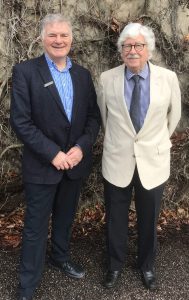
Peter Holt and Peter Stubbs
1st February 2022
Possibly the most famous and enduring image of King Henry VIII is of a supremely powerful-looking broad-shouldered man, standing with his legs planted firmly apart, dressed in the finest and expensive clothes, and staring fixedly out of the picture at the humble viewer. For this image, we can thank the sixteenth century artist, Hans Holbein the Younger, and it was the life and achievements of this particular portraitist that were the subject of this talk by club member, Steve Marsh.
In order to distinguish him from his father who was also a painter, Hans Holbein is known as ‘the Younger’ and was born in Augsburg, Germany in about 1497. By the time that he reached his late teenage years, his considerable talent as an artist had been recognized and he moved to Basel, Switzerland to work as an illustrator of books. He became acquainted with the humanist Erasmus whose recommendation led to Holbein’s acceptance into the circle of the influential Sir Thomas More when he moved in search of work to England in 1526. Here he built a high reputation for portraiture and, after a visit back to Basel where his wife and family still lived, he returned to England where he painted many members of the English Court including Henry VIII’s second wife, Anne Boleyn, and the king’s chief minister Thomas Cromwell.
The speaker included in his talk a section describing the developing techniques used by Holbein during his career. Preliminary sketches were used as the basis of his finished pictures and are themselves works of art. Other paintings, notably ‘The Ambassadors’ of 1533 are rich in symbolism which, to this day, is the subject of debate and interpretation.
This was a talk that Steve had clearly researched in great detail and was on a subject, Fine Art, which rarely features as a topic for the club’s speakers. As such, it was particularly appreciated by his audience.

Henry VIII
18th January 2022
According to Winston Churchill, “Democracy is the worst form of government – except for all the others that have been tried.” This possibly cynical view may be attributed to the fact that, although having successfully led the nation through World War II, he had just been voted out of office in 1945. But this proved the fundamental advantage of a democratic system – democracy gives people the right to choose their rulers. However, there are threats to the system in our country, and these were examined by our speaker, club member Roger Truscott.
Starting his talk by looking at the changes that have taken place, and are continuing, in the spheres of UK politics and social attitudes (‘internal risks’), Roger expressed his view that many of these are leading to a breakdown in the democratic process. Our ‘first-past-the-post’ electoral system may result in relatively stable government but, by its very nature in which two major parties dominate parliament, the proportion of the electorate that does not support either of these parties feels under-represented and resentful. This leads to a growing alienation towards ‘central’ government and threatens the break-up of the UK itself, a process which has already started with the creation of separate governments and assemblies for Scotland, Wales and Northern Ireland. As for England, local authorities, having been stripped of many of their powers and responsibilities, resent the over-centralisation of government in Westminster which is seen to have resulted in the unfair concentration of wealth and influence in London and the Southeast.
Continuing his theme, Roger said that he believed other threats come from those people who reject the whole concept of our democracy. Fanatical adherents to religious and similar beliefs seem determined to further their causes, even though the overwhelming majority of the population is completely opposed to them. Of course, although many of these fanatics are native to the UK, many more are based abroad and hence, come under a second category of threats identified by Roger, namely, ‘external risks’. Included in these are the threats posed by hostile major powers: principally Russian antagonism to the West under Putin and the problems of NATO and European solidarity; and China’s challenge to the West under Xi Jinping within the Asia-Pacific region and in the wider world.
Unsurprisingly, at its conclusion, such a topical and serious talk generated a great number of questions and discussion from the audience.

Roger Truscott
4th January 2022
Are we alone in the universe? In all probability, since man first walked on the Earth, he has looked up into the night sky at the stars and wondered if there were other beings ‘out there’. Even now, after centuries of scientific development, we humans are no closer to a definitive answer, although we have sufficient knowledge of the size and nature of the universe to arrive at the reasonable conclusion that we are unlikely to be the only sentient life forms to have evolved.
In addressing the question of whether or not there may be life elsewhere, the speaker at this meeting, club member Paul Davies, discussed the evidence available to us. As he pointed out, claims for the existence of extra-terrestrials date back thousands of years but it has been only during the past couple of centuries, following major discoveries in astronomy, physics and mathematics, that making contact (either friendly or hostile) with such creatures has been thought a possibility. This has spawned the interest in ‘science fiction’ and UFOs (i.e. unidentified flying objects, many of which are hoaxes, some easily explained, and others that are inexplicable but reported by credible witnesses).
Paul then examined the factors to be considered when assessing the possibility of the existence of life in other parts of the cosmos and the feasibility of making contact. Firstly, there is the sheer scale of the universe. Not only is it spatially vast, but it is populated by billions of galaxies, each of which contains billions of stars. It is reasonable to assume that if only a tiny proportion of these stars are orbited by planets similar to those of our own solar system there must nevertheless be a significant total number of these exoplanets with the potential for life to evolve.
Next, there is the question of the level of evolution achieved by life on these planets and how this compares with our own. Contact between ‘intelligent’ alien life and ourselves would also need to take into account the time taken for any electromagnetic messages (travelling at the speed of light) to reach us. It could be that by the time the signal is received, one or both of the life forms could no longer exist.
This was an extremely interesting talk which the speaker concluded by stating his own conclusions that there is almost certainly life elsewhere in the universe and it is highly possible that there are intelligent life forms out there; but it is unlikely that we shall succeed in making contact.
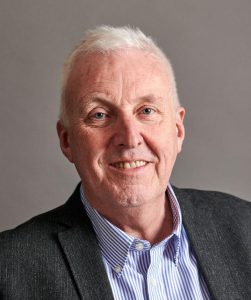
Paul Davies

© Bakewell and District Probus Club, 2014-2024